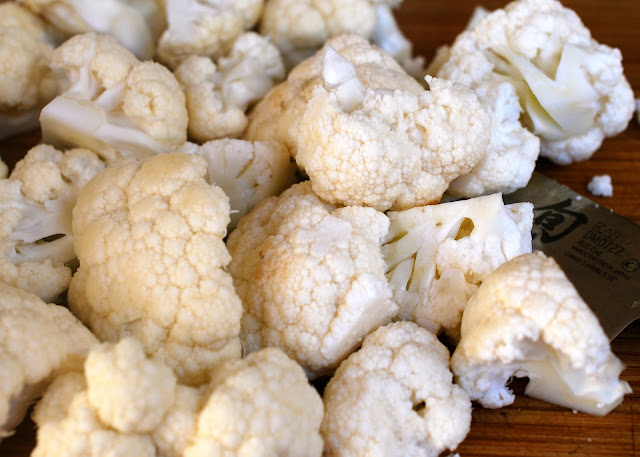Roasted Cauliflower & Shallots
with Rainbow Chard & Dukkah
Serves 8 –
10
 |
| Roasted Cauliflower & Shallots with Rainbow Chard & Dukkah |
This is a surprisingly good (and
simple) dish. Surprising because it
tastes much better than you think it might and looks amazing, especially if you
use rainbow chard. ANY roasted vegetables are fabulous, and cauliflower is no
exception. Swiss chard is also unexpectedly sweet and buttery tasting. It
is in season now and so good for you – full of those antioxidants the experts
say we need (vitamins A, C and E) – plus a ton of vitamin K (good for blood
clotting and bruise-healing) and a bunch of B vitamins. Despite the health
benefits, it really tastes good. But, I believe the real darling of this dish is Dukkah!
 |
| Beautiful cauliflower |
Dukkah is popping up everywhere. I
have found it recently at Whole Foods, an olive oil store and Trader Joes. I am certain Costco will soon supply 5 lb.
bags! However, buyers beware. Recipes are all over the map on what to include.
This dearly loved Egyptian specialty is a loose mixture of nuts and spices in a
dry crushed, but not powdered form, often eaten with bread dipped in olive oil.
It can be sprinkled over leafy salads, roasted vegetables, bean pastes such as
hummus, and simply cooked rice or lentils. It is simple to make and fun to
share. The recipe below is one of my favorites (see below). You can prepare it
in advance and store in an airtight container for a month or so.
- 1 large cauliflower (3 lb), cored and cut into florets about 1½ “ wide
- ¾ lb. whole shallots, peeled, and cut in half, if large
- 5 Tb olive oil (divided)
- 1 tsp kosher salt
- ½ lb. Swiss chard, stems and ribs sliced and leaves chopped
- 1 can (15 oz) chickpeas, rinsed and drained
- ½ C Dukkah
Prepare the Swiss chard. First, give them a good rinse in the sink. Twice. Even
greens bought at the grocery store can carry a lot of grit and dirt in the
leaves. I usually fill up the sink with warm (not hot) water and give the chard
several good swishes. The grit rinses away and sinks to the bottom. You can use
a kitchen towel to pat the excess water from the leaves.
 |
| Rainbow chard |
Trim the stalks from
the stems. Stems and thick ribs need more cooking than the leaves so it is
important to separate them. Cutting the stem is like cutting a “V” from the
leaf. Once the stems and thick ribs are
removed, fold the leaves in half, lengthwise and roll them up and chop them
(put them into a salad spinner to spin off the excess water if needed). Chop
the ribs and stems as well. You could wash, chop and dry the chard the day
before if that works best for your schedule. Store wrapped in a paper towel in
a plastic bag in your frig overnight.
 |
| Cut up chard |
Preheat oven to 425 degree F. In a roasting pan, toss cauliflower and shallots with 3 Tb olive
oil and 1 tsp salt. Roast,
stirring occasionally, until light golden, about 20 minutes. Add chard stems
and ribs, toss to coat and roast an additional 7 – 10 minutes until all
vegetables are tender.
Stir chard leaves, rinsed and
drained chickpeas, dukkah and remaining 2 Tb olive oil into same pan. Roast until chard leaves
are wilted and tender, about 8 minutes. Stir, season to taste with salt and
additional dukkah. Serve to rave reviews!
 |
| Chickpeas |
Dukkah
- 1½ Tb coriander seeds
- 1½ tsp cumin seeds
- ½ tsp kosher salt
- ½ tsp freshly ground pepper
- ¼ tsp dried thyme leaves
- ¼ C roasted hazelnuts
- ¼ C toasted sesame seeds
Toast coriander seeds and cumin
seeds in a small frying pan over med-low heat until a shade darker, about 5-7
minutes. Let them cool. Be sure not to burn the seeds, removing them from the
heat as soon as they begin to pop. They will just begin to color and give off a
slight aroma.
Whirl cooled seeds, kosher salt,
pepper and thyme in a food processor until finely crushed but not pulverized.
Add the hazelnuts and sesame seeds and pulse a bit more to blend. Be careful to
not over blend, or the oil from the too finely ground seeds and nuts will form
a paste: dukkah should be a crushed dry mixture. Taste and add more salt if
necessary.
Variations are plentiful. Some
people substitute or add peanuts, sunflower seeds or almonds instead of
hazelnuts and some add dried mint, cumin seeds and paprika. Give it a whirl.
Create your own favorite dukkah. It makes for a great hostess gift as well. I
know I would love it! (Hint)
Enjoy!!
Larue


No comments:
Post a Comment